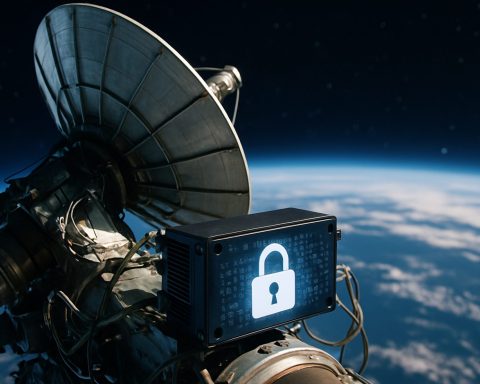- The ULA Atlas V rocket is set to launch Amazon’s first full batch of Project Kuiper satellites, aiming to revolutionize global internet connectivity.
- 27 satellites will embark from Cape Canaveral, targeting improved communication for underserved regions worldwide.
- Project Kuiper’s satellite network intends to bridge the digital divide, competing with existing networks like Starlink.
- Rajeev Badyal, Project Kuiper’s Vice President, emphasizes the mission’s role in advancing communication technology.
- Weather permitting, New Yorkers, particularly in cities like Binghamton and Albany, might catch a glimpse of the rocket’s ascent.
- This mission signifies the beginning of a series of technological achievements aimed at extending connectivity globally.
Wednesday evening promises an extraordinary celestial spectacle, as Amazon launches the first full batch of its Project Kuiper satellites aboard the United Launch Alliance (ULA) Atlas V rocket. This thrilling lift-off, anticipated at 7 p.m. EDT from Cape Canaveral Space Force Station, seeks to transform the global internet landscape and, quite literally, take connectivity to new heights.
Cape Canaveral’s vast azure skies will serve as the backdrop to this groundbreaking mission, as 27 gleaming satellites embark on their journey 280 miles above Earth. The launch represents Amazon’s ambitious attempt to rival networks like Starlink, with the ultimate goal of beaming high-speed internet to underserved regions across the globe. Amazon envisions this satellite network as a bridge over the digital divide, promising to bring previously unimagined connectivity to millions.
The brains behind this technical marvel, Rajeev Badyal, Vice President of Project Kuiper, believes that each launch is an unfolding narrative of innovation and progress. These satellites are engineered to perfection, tirelessly working to enhance communication capabilities and coverage far beyond current limitations.
As the clock ticks towards lift-off, New Yorkers might get a rare chance to witness this ascent. Weather permitting, residents across cities, including Binghamton and Albany, may spot the dazzling trail of the rocket as it climbs skyward. Imagine standing on a quiet street, eyes cast up, catching sight of a glimmering streak that holds the promise of technological revolution.
While the skies over New York are predicted to start clear and sunny, clouds may gather by evening, potentially obscuring the view. But for those lucky enough to have clear skies, the spectacle will serve as a reminder of the brilliance of human ingenuity.
This mission is more than just a launch; it’s a precursor to a series of groundbreaking advancements. With every successful flight, Project Kuiper inches closer to deploying a robust satellite constellation, aimed at connecting the farthest corners of the world to an ever-expanding digital universe.
As rockets roar, the narrative unfolds, revealing a future where the sky is not the limit, but just the beginning. Keep your eyes to the sky, for you might witness not just a launch, but the dawn of a new era in connectivity.
Amazon’s Satellite Ambition: How Project Kuiper is Reinventing Global Connectivity
Introduction
The recent launch from Cape Canaveral marks a significant milestone in Amazon’s ambitious Project Kuiper, set to disrupt and reshape the global internet infrastructure by lobbing an initial set of 27 satellites into orbit aboard a United Launch Alliance (ULA) Atlas V rocket. The intent is clear: challenge existing players like SpaceX’s Starlink and extend high-speed internet accessibility to underserved regions worldwide.
Project Kuiper: Behind the Vision
Rajeev Badyal leads Project Kuiper with a vision of innovation, aiming to bridge the digital divide with this constellation of satellites. These satellites are not merely high-tech hardware; they represent a leap towards ensuring global internet connectivity, particularly in regions lacking reliable access. Amazon’s investment in Kuiper reflects its ambition to leverage satellite technology to expand internet reach.
Real-World Use Cases
In regions with limited traditional internet infrastructure, Project Kuiper can significantly impact education by providing students with access to digital learning resources and connecting remote healthcare facilities to advanced medical support systems. The ability to deliver reliable, high-speed internet service can also foster economic development by enabling e-commerce and access to global markets.
Market Forecasts & Industry Trends
Market analysts predict the satellite internet service industry to grow significantly over the next decade, driven by companies like Amazon and SpaceX. Deloitte’s 2023 Technology, Media, and Telecommunications predictions highlight that satellite broadband will reach over 1 million subscribers globally by 2026. As Amazon brings its vast resources to bear, expect competitive pricing models and service offerings that challenge existing providers.
Features, Specs & Pricing
Project Kuiper is expected to offer competitive speeds and pricing, although specific details remain under wraps. The goal is to provide speeds up to 400 Mbps, aligning closely with some terrestrial broadband services. Pricing strategies will likely be aggressive, aligning with Amazon’s broader strategy of competitive market entry.
Security & Sustainability
Security is paramount as Project Kuiper plans its expansive network, with data encryption and cybersecurity measures integral to its design. Sustainability is also addressed with satellite end-of-life plans ensuring they de-orbit and burn up in the Earth’s atmosphere, minimizing space debris.
Insights & Predictions
The successful launch of Project Kuiper satellites signals the dawn of an exciting era in telecommunications. As satellite technology becomes feasible economically, expect increased competition not only on pricing and speeds but also on the quality of service and coverage area. Partnerships with telecom providers may emerge, integrating satellite solutions with terrestrial networks for seamless connectivity.
Pros & Cons Overview
Pros:
– Expands internet access to remote and underserved areas.
– Provides redundancy and resilience in internet infrastructure.
– Potentially competitive pricing and high bandwidth.
Cons:
– Initial service rollout may be limited geographically.
– High capital investment and regulatory challenges.
– Dependency on space weather and orbital congestion.
Conclusion and Actionable Recommendations
As Project Kuiper unfolds, businesses and consumers should explore opportunities to enhance their internet connectivity through satellite services, particularly in underserved regions. Companies should remain vigilant, assessing how satellite internet might offer complementary or backup connectivity solutions.
– Stay Informed: Follow developments on leading tech and business news platforms to understand how new satellite services impact your market.
– Evaluate Current Needs: Analyze current internet usage patterns to determine if satellite internet could offer an advantage.
– Consider Partnerships: Businesses in remote areas should consider partnerships with satellite providers to enhance infrastructure reliability.
For extensive exploration of Amazon’s technological innovations and market impact, visit the official Amazon site. Keep an eye on how Project Kuiper will reshape digital landscapes and redefine connectivity norms.








